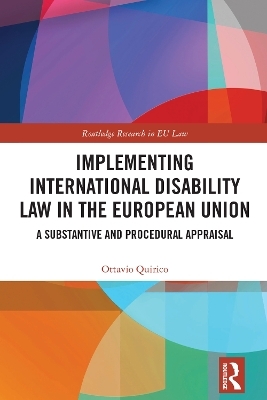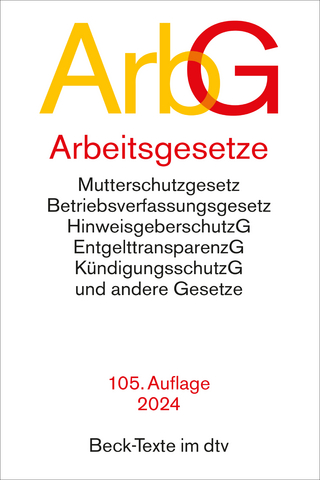
Implementing International Disability Law in the European Union
Routledge (Verlag)
978-0-367-27118-3 (ISBN)
The book is a useful resource for practitioners, policymakers, academics, students, researchers and anyone interested in EU and international disability law and politics.
Ottavio Quirico is a senior researcher in the Department of International Humanities and Social Sciences at the University for Foreigners of Perugia in Italy and a professor in the School of Law at the University of New England in Australia and the Centre for European Studies at the Australian National University. He is also a member of the Research Centre on Transnational Legal Relations at the Federal University of Paraiba in Brazil, an alumnus of the European University Institute in Florence and a member of the Doctoral Committee of the University of Pavia in Italy. Inter alia, he has been a Marie Curie fellow at University Pantheon-Assas in France and has acted as a consultant to the United Nations.
List of abbreviations ix
Introduction: EU multi-layered disability regulation 1
1 The trajectory of disability rights: history and sources of EU disability law 5
1.1 A concise history 5
1.2 The EU and the Convention on the Rights of Persons with Disabilities (CRPD) 11
1.2.1 The (tripartite) structure of the CRPD 11
1.2.2 The EU and the CRPD as a mixed agreement 12
1.2.2.1 Substance: a matter of competence 12
1.2.2.2 Procedure: between national institutions and the Committee on the Rights of Persons with Disabilities (CtRPD) 14
1.2.3 Allowing individual petitions under the Optional Protocol to the CRPD 16
1.2.4 The CRPD between EU law and the law of the Member States 17
1.3 Expanding the frame: the EU and (soft and hard) international obligations outside the CRPD 21
1.4 Disability in the legal sources of the EU jurisdiction 23
1.4.1 Disability in the sources of EU law and the centrality of the Charter of Fundamental Rights 23
1.4.2 Disability in the sources of EU Member States’ law and the key role of action plans 27
1.5 Disability in the Council of Europe sources between the European Convention on Human Rights (ECHR) and the European Social Charter 29
1.6 Prospective accession of the EU to the ECHR and sources of disability law 31
1.7 From fragmentation to harmonisation? The concept of ‘disability’ and the scope of application of disability rules 32
2 Articulating the institutional framework between the EU and Member States 34
2.1 Outlining the EU institutional framework for the CRPD 34
2.1.1 Decision-making (primary rules) 38
2.1.1.1 The European Commission as the core legislative mechanism to implement disability policies (CRPD article 33(1)) 38
2.1.1.2 Parliamentary impulsion 41
2.1.1.3 The polyhedric action of the Council of the EU 43
2.1.2 Rights enforcement (secondary norms) 45
2.1.2.1 The composite EU framework to promote, protect and monitor the implementation of the CRPD (article 33(2)) 45
2.1.2.2 The CJEU, dualism and disability rights under the CRPD 47
2.2 Mapping national institutions under CRPD article 33 50
2.2.1 National frameworks to implement, promote, protect and monitor the CRPD: variable geometry 50
2.2.1.1 Implementing the social disability paradigm in Denmark 50
2.2.1.2 The plurality of CRPD mechanisms in France 54
2.2.1.3 Germany and the implementation of the CRPD in federal States 57
2.2.1.4 Applying the CRPD in Italy as a region-based system 61
2.2.1.5 Comprehensively implementing the CRPD in Latvia 64
2.2.1.6 Romania and disability rights balancing 66
2.2.1.7 Financing deinstitutionalisation in Slovakia 68
2.2.1.8 Ad hoc mechanisms to implement the CRPD in Spain 70
2.3 Nothing about Us without Us: effective participation through representative organisations? 73
2.4 Institutional competence for external action on disability: formal and informal channels 76
2.5 The Council of Europe system, disability and the accession of the EU to the ECHR 78
2.5.1 Mainstreaming disability rights through decision-making 78
2.5.2 Rights enforcement 79
2.5.2.1 The progressive disability policy of the European Committee on Social Rights 79
2.5.2.2 Lights and shadows in the disability jurisprudence of the European Court of Human Rights 81
2.6 Perspectives disclosed by the accession of the EU to the ECHR: progressing disability rights in the light of institutional attrition? 87
3 Improving inclusiveness through substantive regulation 90
3.1 Key directions: ‘twin’ transitions and the 2030 EU Disability Strategy 90
3.1.1 Substance: promoting accessibility internally and externally 91
3.1.2 Implementation: respecting, protecting and fulfilling disability rights 95
3.2 Including people with disabilities in the common market and policy 97
3.2.1 Fostering participation 97
3.2.1.1 Participation and accessibility 97
3.2.1.2 Harmonising accessibility 101
3.2.2 Improving independent living 104
3.2.2.1 Deinstitutionalising EU Member States 104
3.2.2.2 Channelling funding into community-based services 110
3.2.3 Achieving equal access through education 112
3.2.3.1 The struggle for inclusiveness 112
3.2.3.2 Improving inclusiveness 117
3.2.4 Employment as a pathway to inclusion 120
3.2.4.1 The request for an accessible labour market 120
3.2.4.2 Comprehensively reforming employment as the centre of gravity for inclusion 125
3.3 A disability-inclusive sustainable economy: the European Green Deal and disability 128
3.4 Disability-oriented external action 131
3.5 Parallel disability rights developments in light of the accession of the EU to the ECHR? 133
Conclusion: Harmonising the layers 138
Documents 140
Cases 156
Bibliography 160
Index 169
| Erscheinungsdatum | 10.07.2024 |
|---|---|
| Reihe/Serie | Routledge Research in EU Law |
| Verlagsort | London |
| Sprache | englisch |
| Maße | 156 x 234 mm |
| Gewicht | 453 g |
| Themenwelt | Recht / Steuern ► Allgemeines / Lexika |
| Recht / Steuern ► Arbeits- / Sozialrecht ► Arbeitsrecht | |
| Recht / Steuern ► EU / Internationales Recht | |
| Sozialwissenschaften | |
| ISBN-10 | 0-367-27118-4 / 0367271184 |
| ISBN-13 | 978-0-367-27118-3 / 9780367271183 |
| Zustand | Neuware |
| Informationen gemäß Produktsicherheitsverordnung (GPSR) | |
| Haben Sie eine Frage zum Produkt? |
aus dem Bereich


